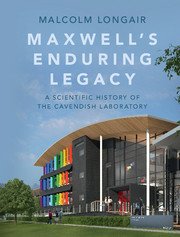Book contents
- Frontmatter
- Dedication
- Contents
- Preface
- Acknowledgements
- Part I To 1874
- 1 Physics in the nineteenth century
- 2 Mathematics and physics in Cambridge in the nineteenth century
- Part II 1874 to 1879
- Part III 1879 to 1884
- Part IV 1884 to 1919
- Part V 1919 to 1937
- Part VI 1938 to 1953
- Part VII 1953 to 1971
- Part VIII 1971 to 1982
- Part IX 1984 to 1995
- Part X 1995 to present
- Appendix The evolution of the New Museums site
- Notes
- References
- Author index
- Subject index
2 - Mathematics and physics in Cambridge in the nineteenth century
from Part I - To 1874
Published online by Cambridge University Press: 05 July 2016
- Frontmatter
- Dedication
- Contents
- Preface
- Acknowledgements
- Part I To 1874
- 1 Physics in the nineteenth century
- 2 Mathematics and physics in Cambridge in the nineteenth century
- Part II 1874 to 1879
- Part III 1879 to 1884
- Part IV 1884 to 1919
- Part V 1919 to 1937
- Part VI 1938 to 1953
- Part VII 1953 to 1971
- Part VIII 1971 to 1982
- Part IX 1984 to 1995
- Part X 1995 to present
- Appendix The evolution of the New Museums site
- Notes
- References
- Author index
- Subject index
Summary
Pure and mixedmathematics at Cambridge
The Galilean revolution culminated in Newton's great Philosophiæ Naturalis Principia Mathematica of 1687. The words of the title are significant: Newton had enunciated the ‘mathematical principles of natural philosophy’. In the course of his elucidation of the basic laws of mechanics, dynamics and gravity, he invented his own version of the differential calculus, the method of fluxions. In keeping with the conventions of the time, however, Newton wrote the Principia entirely in geometrical terms. Newton's book on the Method of Fluxions was completed in 1671 but only published posthumously in 1736. In the meantime, Gottfried Leibniz had independently developed his own version of the calculus about 1673, his book being published in 1684, 50 years before Newton's text. An unpleasant priority dispute developed between Newton and Liebniz. From our present perspective, the significant aspect of the different, but equivalent, approaches was that Newton's fluxions remained the preferred technique in England, particularly in Cambridge, while in continental Europe Leibniz's notation and techniques were adopted and are those commonly used today.
To understand the development of physics and mathematical physics in Cambridge, an important distinction has to be made between two different approaches to the discipline of mathematics. Francis Bacon and Jean d'Alembert made a clear distinction between pure mathematics and what was called mixed mathematics (Brown, 1991). According to d'Alembert's tree of knowledge, pure mathematics consisted of arithmetic and geometry, the former being divided into elementary arithmetic and algebra, which in turn included elementary algebra and differential algebra, the latter including the differential and integral calculus. Geometry included elementary geometry as applied in the fields of the ‘Military, Architecture and Tactics’, and transcendental geometry, which concerned the theory of curves. In contrast, mixed mathematics had as its domain
• mechanics, including statics and dynamics
• geometric astronomy, which included cosmography, chronology and gnomonics, meaning the science of sundials
• optics, acoustics and pneumatics
• the art of conjecturing, which meant the analysis of games of chance.
In modern terms, the distinction between pure and mixed mathematics corresponds more or less to that between pure and applied mathematics.
During the second half of the eighteenth century and the nineteenth century, continental mathematicians made very significant advances in the field of analysis, meaning the branches of pure mathematics which include the theories of differentiation, integration and measure, limits, infinite series and analytic functions.
- Type
- Chapter
- Information
- Maxwell's Enduring LegacyA Scientific History of the Cavendish Laboratory, pp. 35 - 46Publisher: Cambridge University PressPrint publication year: 2016



